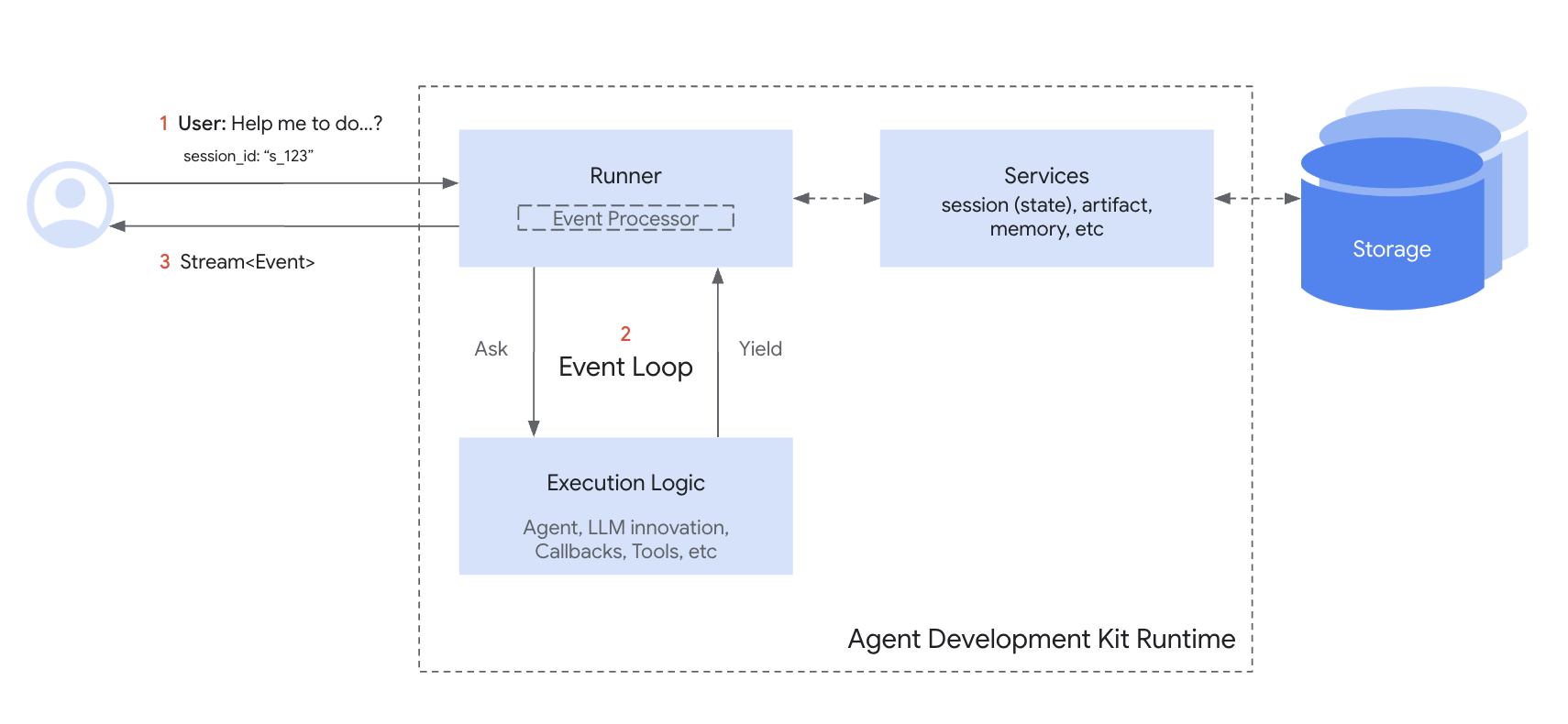Session: Tracking Individual Conversations¶
Following our Introduction, let's dive into the Session. Think back to the idea of a "conversation thread." Just like you wouldn't start every text message from scratch, agents need context from the ongoing interaction. Session is the ADK object designed specifically to track and manage these individual conversation threads.
The Session Object¶
When a user starts interacting with your agent, the SessionService creates a Session object (google.adk.sessions.Session). This object acts as the container holding everything related to that one specific chat thread. Here are its key properties:
- Identification (
id,app_name,user_id): Unique labels for the conversation.id: A unique identifier for this specific conversation thread, essential for retrieving it later.app_name: Identifies which agent application this conversation belongs to.user_id: Links the conversation to a particular user.
- History (
events): A chronological sequence of all interactions (Eventobjects – user messages, agent responses, tool actions) that have occurred within this specific thread. - Session Data (
state): A place to store temporary data relevant only to this specific, ongoing conversation. This acts as a scratchpad for the agent during the interaction. We will cover how to use and managestatein detail in the next section. - Activity Tracking (
last_update_time): A timestamp indicating the last time an event was added to this conversation thread.
Example: Examining Session Properties¶
from google.adk.sessions import InMemorySessionService, Session
# Create a simple session to examine its properties
temp_service = InMemorySessionService()
example_session: Session = temp_service.create_session(
app_name="my_app",
user_id="example_user",
state={"initial_key": "initial_value"} # State can be initialized
)
print(f"--- Examining Session Properties ---")
print(f"ID (`id`): {example_session.id}")
print(f"Application Name (`app_name`): {example_session.app_name}")
print(f"User ID (`user_id`): {example_session.user_id}")
print(f"State (`state`): {example_session.state}") # Note: Only shows initial state here
print(f"Events (`events`): {example_session.events}") # Initially empty
print(f"Last Update (`last_update_time`): {example_session.last_update_time:.2f}")
print(f"---------------------------------")
# Clean up (optional for this example)
temp_service.delete_session(app_name=example_session.app_name,
user_id=example_session.user_id, session_id=example_session.id)
(Note: The state shown above is only the initial state. State updates happen via events, as discussed in the State section.)
Managing Sessions with a SessionService¶
You don't typically create or manage Session objects directly. Instead, you use a SessionService. This service acts as the central manager responsible for the entire lifecycle of your conversation sessions.
Its core responsibilities include:
- Starting New Conversations: Creating fresh
Sessionobjects when a user begins an interaction. - Resuming Existing Conversations: Retrieving a specific
Session(using its ID) so the agent can continue where it left off. - Saving Progress: Appending new interactions (
Eventobjects) to a session's history. This is also the mechanism through which sessionstategets updated (more in the State section). - Listing Conversations: Finding the active session threads for a particular user and application.
- Cleaning Up: Deleting
Sessionobjects and their associated data when conversations are finished or no longer needed.
SessionService Implementations¶
ADK provides different SessionService implementations, allowing you to choose the storage backend that best suits your needs:
-
InMemorySessionService- How it works: Stores all session data directly in the application's memory.
- Persistence: None. All conversation data is lost if the application restarts.
- Requires: Nothing extra.
- Best for: Quick tests, local development, examples, and scenarios where long-term persistence isn't required.
-
DatabaseSessionService- How it works: Connects to a relational database (e.g., PostgreSQL, MySQL, SQLite) to store session data persistently in tables.
- Persistence: Yes. Data survives application restarts.
- Requires: A configured database.
- Best for: Applications needing reliable, persistent storage that you manage yourself.
-
VertexAiSessionService- How it works: Uses Google Cloud's Vertex AI infrastructure via API calls for session management.
- Persistence: Yes. Data is managed reliably and scalably by Google Cloud.
- Requires: A Google Cloud project, appropriate permissions, necessary SDKs (
pip install google-adk[vertexai]), and the Reasoning Engine resource name/ID. - Best for: Scalable production applications deployed on Google Cloud, especially when integrating with other Vertex AI features.
# Requires: pip install google-adk[vertexai] # Plus GCP setup and authentication from google.adk.sessions import VertexAiSessionService PROJECT_ID = "your-gcp-project-id" LOCATION = "us-central1" # The app_name used with this service should be the Reasoning Engine ID or name REASONING_ENGINE_APP_NAME = "projects/your-gcp-project-id/locations/us-central1/reasoningEngines/your-engine-id" session_service = VertexAiSessionService(project=PROJECT_ID, location=LOCATION) # Use REASONING_ENGINE_APP_NAME when calling service methods, e.g.: # session_service.create_session(app_name=REASONING_ENGINE_APP_NAME, ...)
Choosing the right SessionService is key to defining how your agent's conversation history and temporary data are stored and persist.
The Session Lifecycle¶

Here’s a simplified flow of how Session and SessionService work together during a conversation turn:
- Start or Resume: A user sends a message. Your application's
Runneruses theSessionServiceto eithercreate_session(for a new chat) orget_session(to retrieve an existing one). - Context Provided: The
Runnergets the appropriateSessionobject from the service, providing the agent with access to itsstateandevents. - Agent Processing: The agent uses the current user message, its instructions, and potentially the session
stateandeventshistory to decide on a response. - Response & State Update: The agent generates a response (and potentially flags data to be updated in the
state). TheRunnerpackages this as anEvent. - Save Interaction: The
Runnercallssession_service.append_event(...)with theSessionand the newEvent. The service adds theEventto the history and updates the session'sstatein storage based on information within the event. The session'slast_update_timeis also updated. - Ready for Next: The agent's response goes to the user. The updated
Sessionis now stored by theSessionService, ready for the next turn (which restarts the cycle at step 1, usually withget_session). - End Conversation: When the conversation is over, ideally your application calls
session_service.delete_session(...)to clean up the stored session data.
This cycle highlights how the SessionService ensures conversational continuity by managing the history and state associated with each Session object.